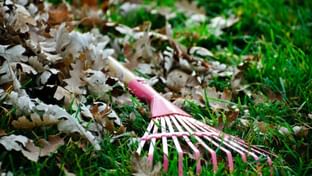Get composting!
Published: 12th January 2022
Starting this week we’re celebrating compost. It’s international Compost Awareness Week from 3rd to 9th May and we’ve organised compost celebration events throughout the month with compost experts, compost to take home and various other bits of information about food. You’re very welcome to attend any of these events and speak to us.
Until the end of May we’re adopting Sarah’s, (our Waste Minimisation Co-ordinator) compost heap and putting it back into active service – with some help from a few compost experts including you!
If you don’t have a garden you can still compost or recycle your food peelings, leftovers and cut flowers.
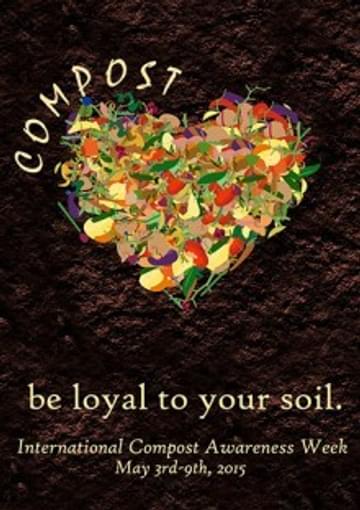
Why compost at home?
It’s quite interesting to see your grass cuttings, food peelings and other things break down to form compost. It’s not the headache you might think and the compost you produce is really convenient to use on your garden without the need to go buy a heavy bag and carry it home. Your ‘waste’ does something good for you – you can see it and save a bit of money each growing season.
There are loads of reasons, what’s yours?
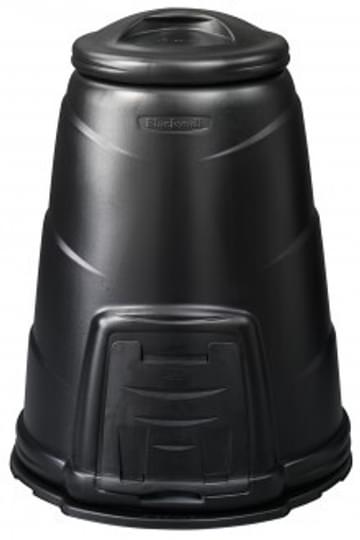
330LTR compost bin
Choosing your bin
There are lots of different types of compost bin you can buy, you’ll probably recognise this black compost bin here. Most councils offer compost bins available for sale at reduced rates. There are lots of things to think about when choosing the bin for you – what surface you’re putting it on, space, how your garden is laid out, whether you have children and pets, and your experience to name a few. At Sarah’s they’ve chosen to have a heap instead of a bin, she says it’s so she’s more likely to remember to look after it if it’s in full view.
Sarah’s chosen to have a 1 metre square area for the heap in a part of the garden that not really suitable for anything else (without a lot of work). There are 3 sections made with old fence panels, the idea was that items would be added on the left then when that was full the next one would be used but it hasn’t actually happened that way!
The section on the far right was used first and what you can see in the picture is what’s left of the pile of composting things from about 18 months ago (it takes at least 9 months to get compost). On the left is the pile that’s been added to for the last 9 months or so. The peelings and grass cuttings have just been piled on.
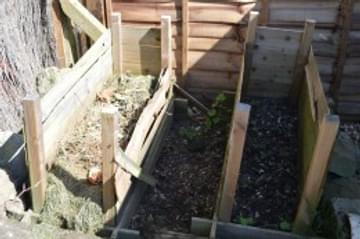
Sarah’s compost heap before TLC

Eggs shells and tea bags
Getting started
So to get it back in to service and give you something interesting to read over the next month this is what she’s done so far before sharing it with all of you.
The first thing was to remove the weeds growing in the middle and right sections. Weeds shouldn’t be composted because they tend to seed so these went in to the garden waste this time. Looking closely at the compost on the right you can still see the egg shells and bags from the tea bags but as the rest has broken down. It’s now been taken out of the compost heap and dug in to a raised bed. It may help if you squash egg shells before putting them in and rip open the tea bags. Some people don’t put egg shells in at all because any egg residue may attract rats or foxes. Home made compost doesn’t look like shop bought compost but it’s very high in nutrients from the food peelings and once it’s mixed in with the rest of the soil you can’t tell the difference.
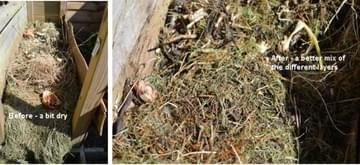
The composting pile on the left doesn’t look particularly compost like yet. You can see the dried grass on top so we’ve mixed it up to allow more air to circulate and to move the different bugs breaking down the organic matter in the pile around. Under the grass you can see that the rest of the pile is beginning to break down and look more like soil. Air, moisture and a good mix of materials are important for good compost – but more about that next week!
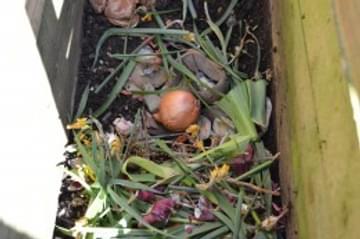
Sarah’s created a new compost pile to celebrate the new compost season. There’s an old ice cream tub on the kitchen side ready to collect the peelings and off cuts of raw fruit and vegetables. Food for the last few days and cut flowers have already been added – this new pile is ready to go be looked after…
Next week we’ll be talking about feeding your compost bin to get the most out of it.
Tell us about your compost bin on Twitter, Facebook or by dropping us an email.
Meterials related to this Event






